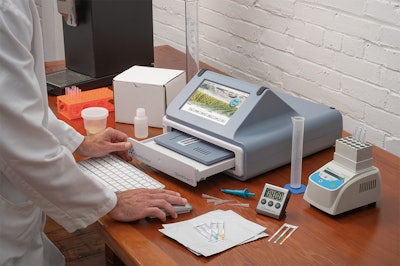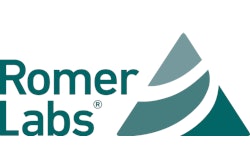
Climate change and mycotoxins: what you need to know
Weather is the largest contributor to mycotoxins across the country, and the U.S. has seen some extreme weather lately, said Christy Swoboda, technical services director for Romer Labs, during our F&G Podcast, “2021 Mycotoxin Harvest Review.”
“Any weather event – drought, heavy rainfall, hurricanes, tornadoes – or just high winds even, can lead to a plant being under stress,” says Swoboda. “Whenever there's stress on a plant, it creates additional avenues for mycotoxin development to occur.”
Corn crops, for example, that have been impacted by drought means keeping an eye open for aflatoxin. Wet and warm conditions can cause an increase in DON contamination. High relative humidity is ideal for fusarium growth.
“There will always be mycotoxins,” she says. “Mycotoxins have been known for hundreds of years. You could even look at some of the early plague events and hypothesize that mycotoxins played a role.”
With the changing climate and rising temperatures, emerging mycotoxins are something else to watch for. “We're still discovering new mycotoxins and understanding the impact of new mycotoxins,” says Swoboda.
Each year we learn more about mycotoxins in grains, and thanks to extreme weather experiences, these toxic substances are becoming more prevalent.
There is also an increased awareness of mycotoxins’ effects on human and animal health. This has intensified the need to test food and animal feed for high-risk ingredients during grain receiving.
Today’s on-site feed mill mycotoxin test kits enable rapid and accurate quantification of these toxic substances at grain receiving to help operators to accept, reject or segregate grain based on mycotoxin levels.
“It’s important to know what levels are coming into a facility and to monitor the effects of storage to create the data points that drive decisions and risk mitigation,” says Megan McCally, product manager for Natural Toxins with Neogen Corp.
Mycotoxin test kit advances
Technology improvements have allowed testing to be taken out of the traditional laboratory setting and placed in the hands of all operators having minimal laboratory experience.
“With staffing shortages across the industry, data integration from the reader to a software system has become mission-critical to preventing and managing mycotoxins from entering the food supply,” says Karen Carmichael, national sales manager, Charm Sciences.
Data management is indeed a trend for testing kits, agrees McCally.
“Most companies are comfortable with collecting data, but we’re seeing a shift toward using that data to drive actionable decisions,” she says.
“As technology continues to advance surrounding data analytics, it only makes sense to apply those innovations to the feed and grain industries.”
Mycotoxin kit developers are focused on developing fast, simple, accurate tests for multiple mycotoxin analysis, says Ryan Whipkey, Global Segment Leader for Mycotoxin and GMO testing, Envirologix.
“Fast and simple tests are required because grain receiving companies cannot suffer operational inefficiencies,” he says. “These facilities must also control for mycotoxin risks in high-risk ingredients.”
How to select the best mycotoxin test kit
When choosing a test kit, make sure it meets the demands of the facility.
“Facilities need to do a risk assessment to determine which grains and feeds need mycotoxin testing,” says Carmichael. “The mycotoxin technology should be flexible to add other grain commodities or toxins as your business needs evolve.”
Features such as workflow, extraction solvent, range of results needed, and kit storage can vary kit to kit.
Whipkey offers these mycotoxin kit selection tips:
- Accuracy. Inaccurate results defeat the purpose of testing. Federal Grain Inspection Service (FGIS)-certified kits are recommended.
- Speed. Large facilities need to process many samples to ensure high levels of plant and labor productivity.
- Simple test instructions. “The probe stand operator is a high turnover position, so having easy to follow instructions is critical to ensure new users are performing the test correctly and obtaining high quality results,” says Whipkey.
- Data management capabilities. “Best-in-class mycotoxin kit suppliers help their customers access their test data in real-time,” he says. “This helps them make better risk management and merchandising decisions.”
Mycotoxin tests should be user-friendly for any employee to perform the test, reducing potential errors from the measurement.
Your supplier is also key when it comes to selecting the right test kits.
“Always consider the relationship you have with a vendor,” says McCally. “Training availability and ease of ordering can make a huge difference during a busy harvest season.”
VICAM
Vicam's Vertu TOUCH lateral flow strip test reader works in concert with Vertu strip tests and offers a full-range quantitative results for up to six major mycotoxin in 10 minutes.
Unit features simple, touchscreen operation and on-board data storage and transfer. Tests are easily performed on-site or in the lab, with precise results automatically stored, printed or shared.
Charm Sciences
Charm Sciences has developed test kits for aflatoxin, DON (vomitoxin), fumonisin, ochratoxin, T-2 toxin and HT-2 toxin, and zearalenone.
“Our mycotoxin method advancements have focused on water-based extractions to eliminate the need for organic solvents and meet sustainability needs and safety concerns at the factory,” says Karen Carmichael with Charm Sciences.
Test results integrate directly from the reader to software/LIMS system connected to PLC pump systems. Auto-text/email alerts allow grain facilities and mills to prevent contaminated grains from entering the facility.
Envirologix
The TotalTox product line is accurate, fast and simple and is complemented by the cloud-based data management product, TotalHub.
The system includes the TotalTox Myco Comb that simultaneously tests four of the most common mycotoxins (aflatoxin, DON, fumonisin, and zearalenone) with prep-to-read speed in under seven minutes.
“TotalTox technology increased the speed and ease of testing for multiple mycotoxins because the tests all use the same instructions, are contained in one device for easy handling, and are all read simultaneously on one, multi-purpose platform, the QuickScan),” says Ryan Whipkey with Envirologix.
With TotalTox, multiple mycotoxins can be tested at grain receiving without causing operational issues.
“With our data portal, TotalHub, quality managers, operations managers, and grain merchandisers have frictionless access to test data so they may optimize mycotoxin testing plans, manage grain suppliers, and capture emerging merchandizing opportunities.”
EnviroLogix also has rapid tests for ochratoxin and T-2/HT-2 that integrate with TotalHub. EnviroLogix is working toward bringing these tests onto the TotalTox common protocol.
NEOGEN
NEOGEN covers all six major toxins (aflatoxin, DON, fumonisin, zearalenone, ochratoxin, and T-2/HT-2). The company offers both ELISA and lateral flow test kit formats. Within the ELISA platform, it offers solvent extractions, aqueous extraction and high sensitivity kits.
“Our two latest technology offerings are the Raptor® platform and the Endpoint kits,” says Megan McCally with NEOGEN.
“Our Raptor reader offers semi-automated testing capability to increase accuracy and reduce user error.”
The Raptor platform also includes a data manager program and the ability to connect seamlessly with a company’s LIMS system
Operators can add their sample and walk away while the test strip develops, reads and records the result.
“We recently worked with industry partners to create our Endpoint line of kits — this kit incubates the sample outside of the reader to add an additional workflow option for high throughput users,” says McCally.
Romer Labs
The AgraStrip® Pro WATEX®test system enables the rapid and simple on-site quantification of mycotoxins in a variety of agricultural commodities. Both extraction and assay have been streamlined, reducing steps to a bare minimum while setting new standards in accuracy.
The AgraStrip system offers a simple three-step procedure to assess commodities for total aflatoxin, deoxynivalenol, total fumonisin and zearalenone.
AgraStrip Pro Zearalenone WATEX rapid test kit recently received Federal Grain Inspection Service (FGIS) approval in April.
With the newly developed AgraVision Pro reader, the system features a shared extraction and dilution procedure and an intuitive walk-way operation to allow simple testing for several different mycotoxins in less than 10 minutes while helping to eliminate common handling errors.
The system can independently and simultaneously test up to four samples. The assay takes only four minutes and the reader control timing, temperature and flow, all in a streamlined procedure.



















